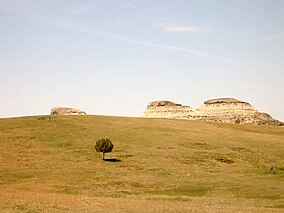Little Missouri National Grassland
| Little Missouri National Grassland | |
|---|---|
 | |
| Location | North Dakota, United States |
| Nearest city | Medora, North Dakota |
| Coordinates | 47°05′56″N 103°32′13″W / 47.099°N 103.537°W[1] |
| Area | 1,028,784 acres (4,163.34 km2)[2] |
| Established | June 23, 1960 |
| Governing body | U.S. Forest Service |
| Website | Little Missouri National Grassland |
Little Missouri National Grassland is a National Grassland located in western North Dakota, United States. At 1,028,051 acres (416,037 ha),[3] it is the largest grassland in the country.[2] Enclaved within its borders is Theodore Roosevelt National Park with an additional 70,446 acres (28,508 ha), which is managed by the National Park Service. The Little Missouri National Grassland was once a part of the Custer National Forest, but is now a part of the Dakota Prairie Grasslands, a National Forest unit consisting entirely of National Grasslands. A predominant feature of the grassland is colorful and beautiful badlands, a rugged terrain extensively eroded by wind and water. It is a mixed-grass prairie with both long and short grass.[4][5]
The Little Missouri River meanders through the grassland and White Butte, North Dakota's highest point, is located in the extreme southeast corner, south of the town of Amidon.
In descending order of land area, it is located in parts of McKenzie, Billings, Slope, and Golden Valley counties. Within the boundaries of the national grassland are significant portions of state-owned and privately owned land, much of it leased by cattle ranchers for grazing.
The grassland is administered by the Forest Service as part of the Dakota Prairie Grasslands from offices in Bismarck, North Dakota. There are local ranger district offices in Dickinson and Watford City.[4]
Oil and gas exploration, extraction, and distribution in the region has the potential for long term negative impacts on the soil, water, vegetation, and wildlife of the grassland, including threatened and endangered species.[6]
See also
References
- ^ "Little Missouri National Grassland". Geographic Names Information System. United States Geological Survey, United States Department of the Interior. Retrieved December 9, 2012.
- ^ a b "Land Areas of the National Forest System". U.S. Forest Service. January 2013. Archived from the original on December 1, 2012. Retrieved December 9, 2012.
- ^ Moul, Francis (2006). The National Grasslands - A guide to America's Undiscovered Treasures. Nebraska: The Ronald K. and Judith M. Stolz Parks Publishing Fund. pp. 67. ISBN 9780803283206.
- ^ a b "Dakota Prairie Grasslands". U.S. Forest Service. Retrieved December 9, 2012.
- ^ Macek-Rowland, K.M. Studying the Effects of Land Use on Sediment Loads, Little Missouri National Grasslands, North Dakota (Report). USGS. Retrieved December 9, 2012.
- ^ Butler, Jack L.; Ott, Jacqueline P.; Hartway, Cynthia R.; Dickerson, Brian E. (November 2018). Biological Assessment of Oil and Gas Development on the Little Missouri National Grassland (PDF). Fort Collins, CO: U.S. Department of Agriculture, Forest Service, Rocky Mountain Research Station. Retrieved December 2, 2018.
External links
 Media related to Little Missouri National Grassland at Wikimedia Commons
Media related to Little Missouri National Grassland at Wikimedia Commons- Dakota Prairie Grasslands - U.S. Forest Service
